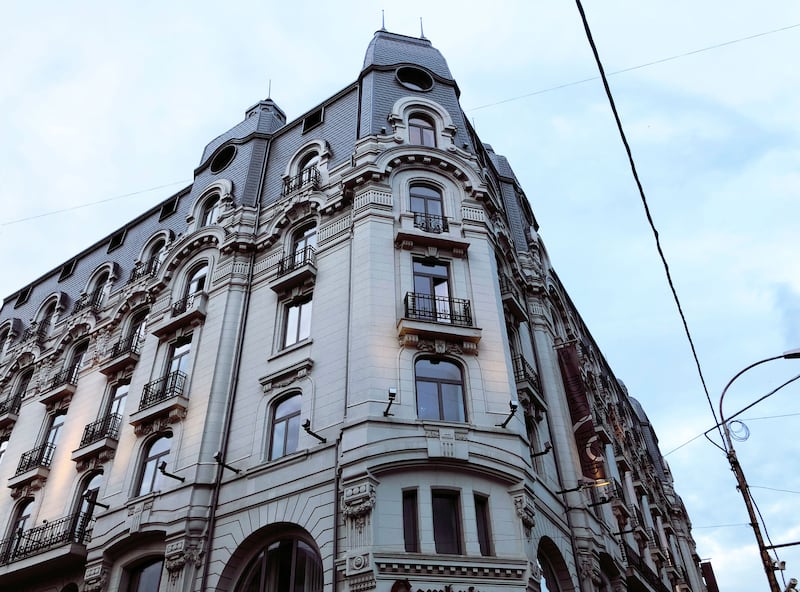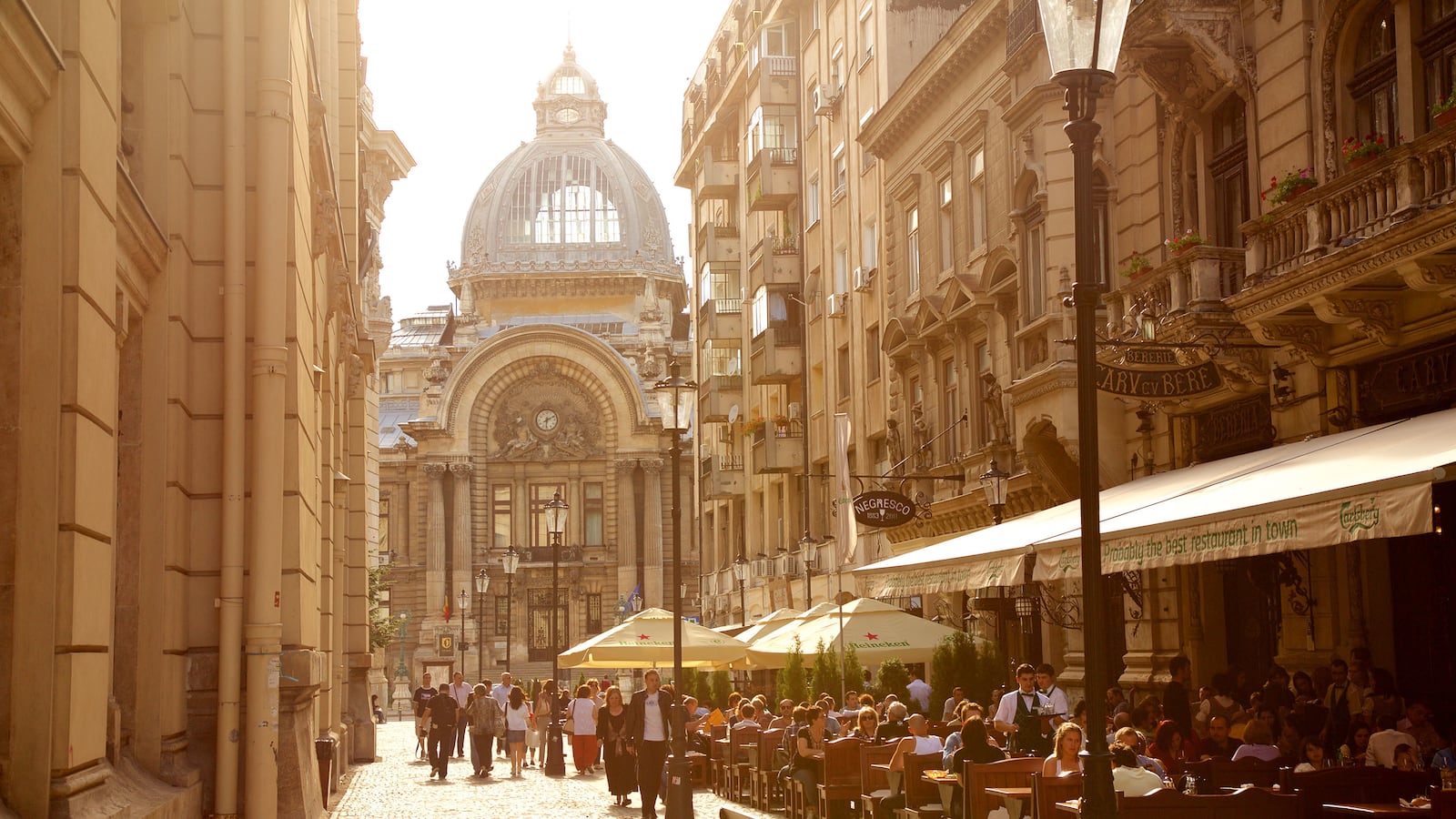There are more than a half-dozen self-titled “Little Viennas” in Europe, preening for the honor of second place. Fewer cities compete for the diminutive “Little Paris” Grand Prix but there are some. The former were almost entirely within Austria-Hungary for decades or centuries, and accordingly their Habsburg yellow Baroque buildings, mini-Ringstrasses and similar trappings are all easy to explain. Little Parises are different; they tend to be much farther away and were never subject to rule by real Paris. They’re enthusiasts rather than offspring, such as the German city of Leipzig and Plovdiv in Bulgaria but the unquestionable and implausible best of the lot is Bucharest.
Among the very numerous attractions of the Romanian capital is a stock of French Renaissance Revival, neoclassical, and Beaux-Arts buildings to put almost any city outside of the French capital to shame, all the more interesting because they aren’t sited in any coherent sequence of a national vernacular but are located more than 1,000 miles from France amidst a cityscape of older Byzantine and Ottoman-styled buildings, later Byzantine Revivalism, and an excellent collection of interwar modern and Art Deco buildings. It doesn’t make sense but the result is brilliant.
Take a stroll down the Calea Victoriei, the principal thoroughfare of Bucharest’s Old Town and you’ll find French-styled architecture on nearly every block. Bucharest doubles as Paris not infrequently in media, from Killing Eve to an early 1990s Michael Gambon Maigret series. Trademarks of Beaux-Arts architecture are everywhere, and these generally aren’t even knockoffs by any standard. Several were built by French architects; most were built by Romanian architects, but generally ones educated at the École des Beaux-Arts in Paris during its prime decades. How does one explain it?
The rise of Romanian nationalism over the earlier decades of the 19th century found unique inspiration in (and concrete help from) France. Romania, which in the pre-national form of the provinces of Wallachia and Moldavia had been an autonomous portion of the Ottoman Empire for centuries, was actively interested in turning away from the traditions of its Ottoman overlords. Russia, which eyed it hungrily, occupying its territories twice and seeking to conquer it in the Crimean War was obviously not an example it sought to emulate. Nearby Austria-Hungary was viewed warily as well, as another possible conqueror of a neighbor already ruling over several million ethnic Romanians in Transylvania.
A particularly vital interest of Romanian nationalists was stressing the Latinity of their civilization, the westernmost Romance language group amidst Slavs, Turks, and Greeks. Not unsurprisingly, commemorative links to Ancient Rome became ubiquitous (there seems to be a commemoration of Roman Emperor Trajan in every Romanian city) but Italy was a geographic expression, France was a great state, and the worthy focus of aspirations. France was also quite politically helpful.
Ironically, it was Russian occupation that provided broader exposure to the French language. Emanuela Constantini explains in Dismantling the Ottoman Heritage? The Evolution of Bucharest in the Nineteenth Century, “The Russian aristocracy, to which the officers of the Tsarist army belonged, used French as a common language. During the Russian occupation of Wallachia in 1806-1812 and again in 1829-1834, the local nobility came into contact with Russian officers, and French literature, dances and traditions began to circulate.”

Romanian enthusiasm for France took on numerous aspects: it imported a huge number of loanwords from French beginning in the 19th century. Estimates vary but roughly 20 percent of the entire Romanian lexicon consists of French loanwords (considerably more than it imported from other Romance languages, from any Slavic neighbors, or from Turkish). The French imprint on the language is unmistakable. You arrive at the Aeroportul, or the Gara de Nord, drive in on a Bulevardul (which were often inspired by Haussman’s Paris from the start). Informal thanks is easy as “mersi.” The military police are Jandarmeria.
The airport is named after Henri Coandă, an aviator who spent extensive time in France. Paris seemed an obligatory stop for generations of Romanian artists in countless fields. George Enescu, Constantin Brâncusi, Victor Brauner, Tristan Tzara, Emil Ciroan, Eugen Ionescu, Theodore Pallady, and Nicolae Grigorescu. And of course a huge number of Romanian architects studied at the Ècole des Beaux-Arts: when Romanian architecture schools were founded they were heavily influenced by the Beaux-Arts model.
Go for a flânerie through the old town for a more than mildly surreal sense of dislocation from whatever geographic architectural moorings you’ve acquired.
There’s something Gare de Lyon-like about the French Renaissance Palace of Justice just south of the Old Town, which was the work of Albert Ballu (and eminent Romanian architect Ion Mincu, Beaux-Arts educated, naturellement), who designed the Palais de Justice in Charleroi in Belgium, along with the train station and cathedral in Oran.
Venture north on the Calea Victoriei and you’ll find Alexandru Săvulescu’s Beaux-Arts Romanian National History Museum, formerly the Central Post Office, reportedly inspired by the main Geneva post office, and bearing more than a mild resemblance to the Natural History Museum at the Jardin des Plantes in Paris, although it boasts grander features than either, wonderful cupolas, and an excellent collection.

Across the street is one of Bucharest’s most ravishing buildings, the CEC Savings and Deposit Bank Palace (designed by Paul Gottereau of Perpignan and the École Des Beaux-Arts). It bears a resemblance to the Petit Palais in Paris but is far more ornate and frankly interesting, boasting one of the most brash and beautiful archways in the Beaux-Arts corpus and an array of solid and glass Renaissance domes bringing internal order. It’s now a banking museum but there’s nothing dry about its majestic interior, featuring a range of murals and resplendent light.
A little north, and somewhat concealed, is the wonderful Macca-Vilacrosse Arcade, designed by another Frenchman, Felix Xenopol. This obvious nod to Parisian passages couverts actually consists of three short arcaded glass-roofed streets that meet under a grand dome of green and yellow glass—its odd shape, and current charm, the result of a hotel that refused to relocate.
Slightly north is the Military Circle, featuring the neoclassical Military Circle Palace (currently swathed for construction) and not one but two French neoclassical-styled hotels, Arghir Culina’s Hotel Capitol (formerly the Magasin de Luvru, you can guess the palace they had in mind) and Alexandru Orascu’s Grand Hotel du Boulevard (not Bulevardul, to be clear) whose marbled interiors are also very elegant.
Soon you’ll arrive at a series of grand Piaţas (an Italian loanword here), fronted by Paul Gottereau’s Carol I University Central University Library building, which resembles the Pantheon Sorbonne in configuration, across the street from the National Museum of Art of Romania, located in the former Royal Palace. Inside there are works by Pissaro, Signac, Courbet, Boudin, Monet, and Camille Claudel, but more importantly a superb collection of Romanian artists you likely haven’t seen, including Nicolae Gregorescu, another Beaux-Arts grad, Romania’s greatest Courbet disciple, plein air painter, and Impressionist, but an excellent range of artists from the 1850s to 1980s, including Theodore Aman, Gheorgae Petrascu, Max Hermann Maxy, Nicolae Tonitza, Marcel Iancu, Victor Brauner, Corneliu Baba, and of course Brancusi. The remainder of the European collection is also great, including Tintoretto, Bronzino, multiple El Grecos and Rembrandts, and Brueghel the Younger’s Seasons series.
The neoclassical Romanian Athenaeum concert hall a little farther up was designed by Albert Galleron on the recommendation of Charles Garnier, architect of the Opera Garnier in Paris.
The “Lipscani” (Romanian for Leipzig, that littler Little Paris, need I remind you) district east of Calea Victoriei features Bucharest’s mercifully small concentration of tourist-oriented dreck amidst many more lovely blocks and buildings such as the National Bank of Romania by Bernard and Galleron, and Alexandru Orăscu’s neoclassical main Bucharest University Building. Admire more of the lovely Beaux-Arts in the obstreperously arched and Renaissance-domed Strada Doamnei 11 and go inside for the similarly appealing antiques market.
The Ministry of Agriculture a bit to the east seems a chateau amidst the city, a more conscious older revivalism than much of the city’s other Francophilia, this designed by Geneva-born Louis Blanc. Ramble on Strada Biserica Amzei and Strada Henri Coandă both of which contain all sorts of fine things. The Vasile Pârvan Institute of Archeology by Jean Berthet on the latter is particularly nice.
You will find quite a lot that isn’t Parisian along this stretch: if what you want is Paris, just go there. It’s the contrast between these French-styled buildings and their very different physical and cultural surroundings that makes for the magic of Bucharest. The Kretzulescu, Zlatari, and Biserica Doamnei churches along the Calea, generally small but splendid Byzantine-styled churches are but a handful of the dozens of historic churches in this overwhelmingly Romanian Orthodox country. Their exteriors are often relatively simple but interiors are full fresco iconography over every internal inch.
The Lipscani District holds a number of relics of older Bucharest: The Stavrapoleus Monastery, architectural remnants of the former princely court, and excellent Romanian Revival architecture of the period just after Francophilia such as the Marmorsch Bank and the Chrissevoloni Bank.
All this visual splendor won’t sustain life, and another layer of the immense charm of Bucharest is its curious cuisine, perched between Central European elements like Ciorbă sour soups, Sarmale stuffed cabbage rolls, sausages and cutlets and middle dips such as Zacuscă (an eggplant and pepper dip), chopped salads, and a sybaritic range of cheeses and pastries. There are a few Italianate items such as Mămăligă, a frequently superb polenta, and white bean dishes. Beyond this there are very affordable wines and tuica plum brandy. This is all exceptionally affordable by European standards as well, with the lei-dollar rate enabling temporarily princely indulgences.

Be sure to walk east to experience the vital contrast of the Bulevardul Magheru, one of the world’s great showplace Art Deco avenues, deserving a place with diverse company such as Ocean Drive in Miami, Marine Drive in Bombay, the Grand Concourse in the Bronx, and all sorts of locations in Tel Aviv. You’ll see Culina’s Hotel Ambassador, Horia Creanga’s ARO building, the Mining Credit Block at Bulevardul Nicolae Bălcescu 2 and much more. You will have noticed the splendid Adriatica Building back on Calea Victoriei, and nearby the one American design contribution to the city, the Telephones Company by Walter Froy, Louis Weeks.
Follow Magheru this just a bit north to the Bulevardul Lascăr Catargiu and you’re back in maybe-Paris again, with this street lined with many well-preserved villas. The nearby Scientists Club by I.D. Berindey (Beaux-Arts alum of course!) is excellent at 9 Lahovari.
A bit north of the city is the sumptuous French Baroque-Art Nouveau Enescu National Museum housed in the Cantecuzino Palace designed by I.D. Berindey. The museum’s collection isn’t especially great unless you happen to be an Enescu fanatic but the interiors are worth the exceptionally modest price of admission. And nearby there’s another excellent large gallery , the Art Collections Museum, featuring mainly Romanian work, especially those of the Francis Bacon of Romania, Corneliu Baba.
I haven’t mentioned the affliction that is Ceaușescu’s New City, a chunk of Pyongyang which obliterated a sixth of the old city. It’s theoretically pedestrian-friendly but in much the same way that the mall parking lot is: the scale is oppressive, every block and building too long and every bulevardul too wide, a combination that’s exceptionally monotonous, worth a walk mainly to breathe a sigh of relief in returning to the old city. The Parliamentary Palace features some grandiose chambers and quality art but it is a work of rank gigantism, wearying to walk around and more intimidating than impressive from exterior angles.
Ceaușescu’s own villa north of the city in Dorobanți is worth a metro trip. It’s not really the festival of kitsch that photos of its golden bathroom would have you think, and mainly reflects the sort of fairly conservative petit bourgeois taste oddly typical of Eastern Bloc dictators. As usual it’s a traditional charming villa neighborhood for the leader, New Pyongyang or worse for the rest. Garnished by gifts from Mao, the Shah of Iran, and all sorts of others it’s interesting and all peripherally ghastly in the context of his deeds, but the pool is fantastic.
There are risks even with Ceaușescu gone. You don’t have to venture very far at all from the center of the city to encounter buildings in disrepair: the city has an air of dilapidation that’s charming in milder forms but somewhat alarming in its more intense forms: Bucharest was included on the 2016 listing of the World Monuments Fund Watch. That entry pointed out that “A built environment of great historical, social, and symbolic significance is threatened by abandonment and demolition of historic buildings, uncontrolled development, and inappropriate rehabilitation.” Go, and perhaps it will encourage a different trend.

